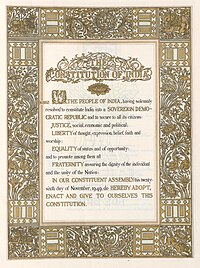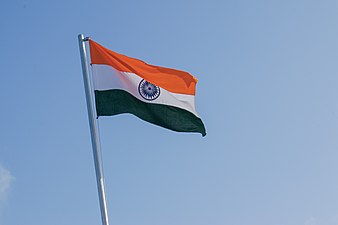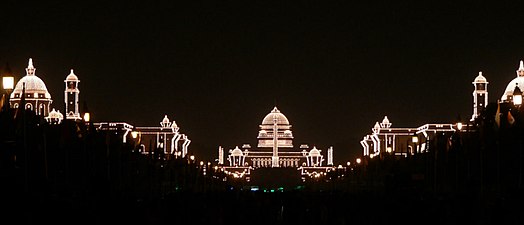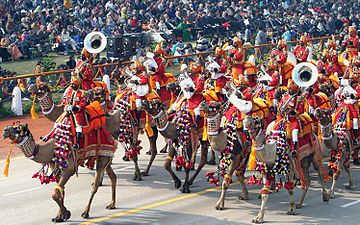Republic Day (India)
| Republic Day | |
|---|---|
 The original text of the Preamble to the Constitution of India. The Constitution of India came into force on 26 January 1950. | |
| Observed by | |
| Type | National |
| Significance | Inception of Constitution of India |
| Celebrations | Parades, distribution of sweets in schools, speeches and cultural dances |
| Date | 26 January |
| Frequency | Annual |
Republic Day is a national holiday in India, when the country marks and celebrates the date on which the Constitution of India came into effect on 26, January 1950, replacing the Government of India Act (1935) as the governing document of India and thus, turning the nation into a newly formed republic.[1] The day also marks the transition of India from an autonomous Commonwealth realm with British Monarch as nominal head of the Indian Dominion, to a fully sovereign republic in the Commonwealth of Nations with the President of India as the nominal head of the Indian Union.
The Constitution was adopted by the Indian Constituent Assembly on 26 November 1949 and came into effect on 26 January 1950 with a democratic government system, completing the country's transition towards becoming an independent republic. 26 January was chosen as the date for Republic day because it was on this day in 1929 when the Declaration of Indian Independence (Purna Swaraj) was proclaimed by the Indian National Congress in lieu of the Realm status as a Dominion later instated by the departing British Regime.
History of Republic Day
India achieved independence from British Raj on 15 August 1947 following the Indian independence movement. The independence came through the Indian Independence Act 1947 (10 & 11 Geo 6 c 30), an Act of the Parliament of the United Kingdom that partitioned British India into the two new independent Dominions of the British Commonwealth (later Commonwealth of Nations).[2] India obtained its independence on 15 August 1947 as a constitutional monarchy with George VI as head of state and the Earl Mountbatten as governor-general. The country, though, did not yet have a permanent constitution; instead its laws were based on the modified colonial Government of India Act 1935. On 29 August 1947, a resolution was moved for the appointment of Drafting Committee, which was appointed to draft a permanent constitution, with Dr B R Ambedkar as chairman. While India's Independence Day celebrates its freedom from British Rule, the Republic Day celebrates the coming into force of its constitution. A draft constitution was prepared by the committee and submitted to the Constituent Assembly on 4 November 1947.[3] The Assembly met, in sessions open to public, for 166 days, spread over a period of two years, 11 months and 18 days before adopting the Constitution. After many deliberations and some modifications, the 308 members of the Assembly signed two hand-written copies of the document (one each in Hindi and English) on 24 January 1950. Two days later which was on 26 January 1950, it came into effect throughout the whole nation. On that day, Dr. Rajendra Prasad's began his first term of office as President of the Indian Union. The Constituent Assembly became the Parliament of India under the transitional provisions of the new Constitution.[4]
On the eve of Republic Day, the President addresses the nation.[5]
Celebrations

The main Republic Day celebration is held in the national capital, New Delhi, at the Rajpath before the President of India. On this day, ceremonious parades take place at the Rajpath, which are performed as a tribute to India; its unity in diversity and rich cultural heritage.[6]
Delhi Republic Day parade
The Delhi Republic Day parade is held in the capital, New Delhi and is organised by the Ministry of Defence. Commencing from the gates of the Rashtrapati Bhavan (the President's residence), Raisina Hill on Rajpath past the India Gate, this event is the main attraction of India's Republic Day Celebrations and lasts for three days. The parade showcases India's Defence Capability, Cultural and Social Heritage.[7]
Nine to twelve different regiments of the Indian Army in addition to the Navy, and Air Force with their bands march past in all their finery and official decorations. The President of India who is the Commander-in-Chief of the Indian Armed Forces, takes the salute. Twelve contingents of various para-military forces of India and police forces also take part in this parade.[8]
Beating Retreat
The Beating Retreat ceremony is held after officially denoting the end of Republic Day festivities. It is conducted on the evening of 29 January, the third day after the Republic Day. It is performed by the bands of the three wings of the military, the Indian Army, Indian Navy and Indian Air Force. The venue is Raisina Hill and an adjacent square, Vijay Chowk, flanked by the North and South block of the Rashtrapati Bhavan (President's Palace) towards the end of Rajpath.[9]
The Chief Guest of the function is the President of India who arrives escorted by the President's Bodyguard (PBG), a cavalry unit. When the President arrives, the PBG commander asks the unit to give the National Salute, which is followed by the playing of the Indian National Anthem, Jana Gana Mana, by the Army. The Army develops the ceremony of display by the massed bands in which Military Bands, Pipe and Drum Bands, Buglers and Trumpeters from various Army Regiments besides bands from the Navy and Air Force take part which play popular tunes like Abide With Me, Mahatma Gandhi's favourite hymn, and Saare Jahan Se Achcha at the end.[10][11][12]
Award distribution
On the eve of Republic Day, the President of India distributes Padma Awards to the civilians of India every year. These are the second highest civilian awards in India after Bharat Ratna. These awards are given in three categories, viz. Padma Vibhushan, Padma Bhushan and Padma Shri, in decreasing order of importance.[13]
- Padma Vibhushan for "exceptional and distinguished service". Padma Vibhushan is the second-highest civilian award in India.
- Padma Bhushan for "distinguished service of a high order". Padma Bhushan is the third-highest civilian award in India .
- Padma Shri for "distinguished service". Padma Shri is the fourth-highest civilian award in India.
While being national honours, the Padma awards do not include cash allowances, benefits, or special concessions in rail/air travel.[14] Per a December 1995 judgment of the Supreme Court of India, no titles or honorifics are associated with the Bharat Ratna or any of the Padma awards; Honorees cannot use them or their initials as suffixes, prefixes or pre- and post-nominals attached to the awardee's name. This includes any such use on letterheads, invitation cards, posters, books etc. In the case of any misuse, the awardee will forfeit the award, and he or she will be cautioned against any such misuse upon receiving the honour.[15]
The decoration comprises a sanad (Certificate) issued under the hand and seal of the President and a Medallion.
The recipients are also given a replica of the medallion, which they can wear during any ceremonial/State functions etc., if they desire. A commemorative brochure giving out brief details in respect of each award winner is also released on the day of the investiture ceremony.[16]
Gallery

The Flag of India on Republic Day

Buildings on Raisina Hill including Rashtrapati Bhavan, lit up during Republic Day 2008.

Surya Kiran Aerobatics Team displaying tricolor.

Border Security Force personnel on Republic Day.

National Security Guard commandos marching in the 2017 Republic Day Parade.
See also
References
- ^ "Introduction to Constitution of India". Ministry of Law and Justice of India. 29 July 2008. Archived from the original on 22 October 2014. Retrieved 14 October 2008.
- ^ "Indian Independence Act 1947". The National Archives, Her Majesty's Government. Retrieved 17 July 2012.
- ^ "Constituent Assembly Debates (Proceedings)". Archived from the original on 29 September 2007. Retrieved 25 January 2014.
- ^ "Republic Day, January 26: History, Significance & Celebration". The Times of India. 25 January 2020. Retrieved 24 January 2021.
- ^ Wangchuk, Rinchen Norbu (25 January 2021). "5 Pre-Republic Day Speeches by Presidents That Told Us How to Preserve the Republic". The Better India. Retrieved 26 January 2021.
- ^ "Republic Day 2020: History, significance and interesting facts". Hindustan Times. 24 January 2020. Retrieved 24 January 2021.
- ^ "India Celebrates 63rd Republic Day". Efi-news.com. Eastern Fare. 26 January 2012. Archived from the original on 15 May 2012.
- ^ "Chap". Mod.nic.in. Archived from the original on 7 March 2011. Retrieved 22 July 2012.
- ^ "Republic Day Beating Retreat Ceremony 2017 at Vijay Chowk, New Delhi". DNA India. 29 January 2017. Retrieved 24 January 2018.
- ^ "Curtain Raiser – Beating Retreat Ceremony 2011". Ministry of Defence. 28 January 2011.
- ^ "Beating Retreat weaves soul-stirring musical evening". The Times of India. 29 January 2011. Archived from the original on 1 February 2011.
- ^ "Martial music rings down the curtain". The Times of India. 30 January 2011. Archived from the original on 4 November 2012.
- ^ "Republic Day Celebration 2021 - Awards Recipients - Know India: National Portal of India". knowindia.gov.in. Retrieved 24 January 2021.
- ^ "Lok Sabha Unstarred Question No. 1219: Padma Awards (2015)"
- ^ "Lok Sabha Unstarred Question No. 2536: Use of Title of Awards (2016)"
- ^ "Govt announces names of 118 Padma Shri awardees on Republic Day eve | See full list". India Today. 25 January 2020. Retrieved 24 January 2021.
External links
 Media related to Republic Day (India) at Wikimedia Commons
Media related to Republic Day (India) at Wikimedia Commons
- January observances
- History of the Republic of India
- Republic days
- Public holidays in India
- Observances in India




